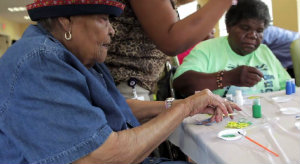 Click photo to watch the Community Catalyst video.
Click photo to watch the Community Catalyst video.You would think having both Medicare and Medicaid would mean getting more of the benefits and services you need.
But for the 10 million people who receive health care coverage under both systems—who are poor and mostly older adults with complex health and social needs—it’s far too easy to fall between the cracks of these good programs. They are structured differently, have different rules, and often lead to a complicated maze of services and providers.
Take the example of Edna and her mother, Sally, who you can meet in the new video from our grantee, Community Catalyst. The video was developed as a teaching tool to help explain the paradox to those who might not have experienced it personally. When Sally, a dually enrolled Medicare and Medicaid beneficiary, became sick and hospitalized, her health care providers weren’t communicating appropriately and she wasn’t receiving the care she needed to stay healthy.
Luckily (not a word we should have to hear in health care), Edna was able to enroll Sally in a high-quality integrated care plan, one that combines the financing and services of both Medicare and Medicaid. She began receiving the kind of health care she deserves—care that is coordinated, comprehensive, continuous, and expertly delivered to meet both her medical and social needs as an older adult.
Health care professionals see her at home, personal aides help her with daily activities, and Sally visits a center, where she has become engaged with other older adults, more active, and more likely to remain healthy and in her community.
The kind of care that Sally is now receiving is what we all need to be advocating, especially for the Medicare/Medicaid population. And Community Catalyst, a national non-profit consumer health advocacy organization, is helping us do just that.
With funding from The Atlantic Philanthropies, Community Catalyst launched the Voices for Better Health initiative and the John A. Hartford Foundation has joined the partnership. Together we are supporting state coalitions that advocate for high-quality, integrated care plans that meet the needs of the Medicare/Medicaid population.
Hartford funding is helping to bring geriatrics health care professionals into these coalitions to lend their expertise to that of the patients, families, and advocates who are striving to ensure that people like Edna and Sally get the care and support they require.
 From left, Ken Pariseau, of Neighborhood Health Plan of Rhode Island; Kyle Allen, of Riverside Health System in Virginia; Semanthie Brooks, of the Benjamin Rose Institute; and Carol Regan, of Community Catalyst, discuss the issues at the Voices for Better Health convening in October.
From left, Ken Pariseau, of Neighborhood Health Plan of Rhode Island; Kyle Allen, of Riverside Health System in Virginia; Semanthie Brooks, of the Benjamin Rose Institute; and Carol Regan, of Community Catalyst, discuss the issues at the Voices for Better Health convening in October.At an October Voices for Better Health convening, for example, state advocates were joined by Hartford grantees Kyle Allen, a geriatrician and vice president for clinical integration at the Riverside Health System in Virginia, and Dawn Butler, a social worker and director of the training center for GRACE Team Care, an evidence-based model for providing care to dual-eligible individuals.
There is a tremendous opportunity right now to improve care for dual-eligible beneficiaries as states take advantage of federal funds to test new models for integrating Medicare and Medicaid (and we appreciate the new federal Medicare-Medicaid Coordination Office spearheading these efforts). The demonstration projects are largely driven by concerns over high costs among this population—an estimated $300 billion annually is wasted due to ineffective care.
But advocates, particularly those supported with technical assistance and funding through Voices for Better Health in the states of Ohio, New York, Michigan, and Washington are there to make sure that while cost is contained, it’s not at the expense of quality.
In most of the experiments to integrate Medicare and Medicaid, states are turning to for-profit managed care plans, giving them per member capitated payments, and letting them coordinate all the medical and social services their beneficiaries need.
While there are managed care companies that can deliver high-quality, patient-centered care (like what Sally receives from Commonwealth Care Alliance), many plans have little experience dealing with a population that has such complex needs. Along with older adults who have a high prevalence of multiple chronic conditions, dementia, and long-term care needs, the dual-eligible population also includes younger adults with disabilities (both physical and mental) and the plans must be able to provide care for everyone in this very heterogeneous group.
Community Catalyst and the state advocacy coalitions have developed a set of priorities for the integrated duals plans, including that evidence-based geriatric care models are built into the regulations and rules for plans set up by states, that the appropriate measures for quality care are put in place, and that consumers have a voice every step of the way.
We invite everyone in our community of grantees and scholars to learn more (you can sign up for the Duals Agenda newsletter), join in the advocacy work, and raise your voice for better health.
